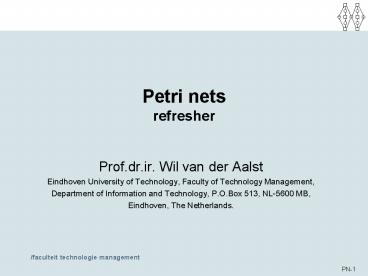PN-1 - PowerPoint PPT Presentation
Title:
PN-1
Description:
Title: PowerPoint Presentation Author: alireza Last modified by: alireza Created Date: 1/1/1601 12:00:00 AM Document presentation format: On-screen Show (4:3) – PowerPoint PPT presentation
Number of Views:43
Avg rating:3.0/5.0
Title: PN-1
1
Petri netsrefresher
- Prof.dr.ir. Wil van der Aalst
- Eindhoven University of Technology, Faculty of
Technology Management, - Department of Information and Technology, P.O.Box
513, NL-5600 MB, - Eindhoven, The Netherlands.
2
Process modeling
- Emphasis on dynamic behavior rather than
structuring the state space - Transition system is too low level
- We start with the classical Petri net
- Then we extend it with
- Color
- Time
- Hierarchy
3
Classical Petri net
- Simple process model
- Just three elements places, transitions and
arcs. - Graphical and mathematical description.
- Formal semantics and allows for analysis.
- History
- Carl Adam Petri (1962, PhD thesis)
- In sixties and seventies focus mainly on theory.
- Since eighties also focus on tools and
applications (cf. CPN work by Kurt Jensen). - Hidden in many diagramming techniques and
systems.
4
Elements
5
(No Transcript)
6
(No Transcript)
7
Rules
- Connections are directed.
- No connections between two places or two
transitions. - Places may hold zero or more tokens.
- First, we consider the case of at most one arc
between two nodes.
8
Elements
9
Rules
- Connections are directed.
- No connections between two places or two
transitions. - Places may hold zero or more tokens.
- First, we consider the case of at most one arc
between two nodes.
10
(No Transcript)
11
Enabled
- A transition is enabled if each of its input
places contains at least one token.
enabled
Not enabled
Not enabled
12
Firing
- An enabled transition can fire (i.e., it occurs).
- When it fires it consumes a token from each input
place and produces a token for each output place.
fired
13
(No Transcript)
14
Play Token Game
- In the new state, make_picture is enabled. It
will fire, etc.
15
(No Transcript)
16
(No Transcript)
17
(No Transcript)
18
(No Transcript)
19
Remarks
- Firing is atomic.
- Multiple transitions may be enabled, but only one
fires at a time, i.e., we assume interleaving
semantics (cf. diamond rule). - The number of tokens may vary if there are
transitions for which the number of input places
is not equal to the number of output places. - The network is static.
- The state is represented by the distribution of
tokens over places (also referred to as marking).
20
Non-determinism
Two transitions are enabled but only one can fire
21
(No Transcript)
22
Example Single traffic light
23
(No Transcript)
24
Two traffic lights
OR
25
Problem
26
Solution
How to make them alternate?
27
(No Transcript)
28
Elements
29
Playing the Token Game on the Internet
- Applet to build your own Petri nets and execute
them http//is.tm.tue.nl/staff/wvdaalst/workflowc
ourse/pn_applet/pn_applet.htm - FLASH animations www.workflowcourse.com
30
Exercise Train system (1)
- Consider a circular railroad system with 4
(one-way) tracks (1,2,3,4) and 2 trains (A,B). No
two trains should be at the same track at the
same time and we do not care about the identities
of the two trains.
31
Exercise Train system (2)
- Consider a railroad system with 4 tracks
(1,2,3,4) and 2 trains (A,B). No two trains
should be at the same track at the same time and
we want to distinguish the two trains.
32
Exercise Train system (3)
- Consider a railroad system with 4 tracks
(1,2,3,4) and 2 trains (A,B). No two trains
should be at the same track at the same time.
Moreover the next track should also be free to
allow for a safe distance. (We do not care about
train identities.)
33
Exercise Train system (4)
- Consider a railroad system with 4 tracks
(1,2,3,4) and 2 trains. Tracks are free, busy or
claimed. Trains need to claim the next track
before entering.































